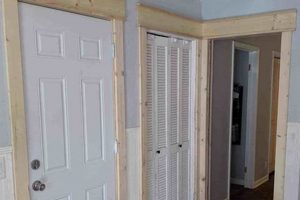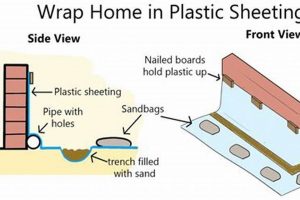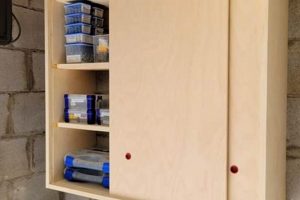Creation of miniature portals, designed to appear as entrances for mythical elfin beings, constitutes a specific category of handcrafted projects. These projects typically involve assembling small-scale doors, often accompanied by miniature furniture or accessories, and affixing them to walls, skirting boards, or trees, to suggest a hidden magical realm. An example includes constructing a small wooden door, painting it in festive colors, and mounting it at the base of a tree in a garden.
The construction and placement of these miniature portals holds significant appeal due to their ability to foster creativity and imagination, particularly in children. They provide an opportunity to engage in artistic expression through design and construction. Furthermore, the practice taps into a cultural fascination with folklore and the supernatural, offering a tangible representation of these beliefs. Historically, small constructed dwellings and miniature representations have held symbolic and spiritual significance across various cultures.
The subsequent sections will explore different methods for constructing these miniature portals, examining material choices, design considerations, and potential applications for diverse settings.
Tips for Miniature Portal Creation
The following guidelines are intended to enhance the construction and presentation of these miniature entrances, ensuring both durability and aesthetic appeal.
Tip 1: Material Selection: Choose materials appropriate for the intended environment. Exterior projects necessitate weather-resistant options such as treated wood or durable plastics. Indoor projects allow for a wider range, including craft foam, lightweight wood, or even repurposed materials.
Tip 2: Scale and Proportion: Maintain a consistent scale relative to the intended location. A disproportionately large portal will disrupt the illusion of a hidden entryway. Measure the intended space and plan the door’s dimensions accordingly. Consider using a ratio, such as 1:12, to ensure consistent sizing for associated miniature items.
Tip 3: Secure Attachment: Employ appropriate adhesives or fasteners to ensure the portal remains securely affixed. For outdoor installations, consider using weather-resistant construction adhesive or small screws. Indoor installations may benefit from removable adhesive putty, allowing for repositioning.
Tip 4: Weatherproofing: If placed outdoors, apply a sealant or weather-resistant coating to protect the portal from moisture damage, fading, and deterioration. Several coats of clear varnish are a good option for wooden components.
Tip 5: Thematic Consistency: Establish a cohesive theme for the project. Consider the surrounding environment and create a design that complements its features. A woodland setting might inspire a rustic, natural portal, while a more urban location could accommodate a whimsical or modern design.
Tip 6: Detail and Embellishment: Add intricate details to enhance realism and visual appeal. Small hinges, doorknobs, and miniature signage can significantly improve the overall effect. Consider using paint washes or dry brushing techniques to create a weathered or aged appearance.
Tip 7: Lighting Considerations: Incorporate miniature lighting elements to create a captivating nighttime display. Battery-operated LED lights or solar-powered options can add a magical ambiance. Be mindful of light placement to avoid overpowering the overall design.
Effective application of these guidelines will result in a more visually appealing and enduring final product, maximizing the imaginative impact of the miniature portal.
The article will now proceed to examine advanced techniques and creative applications within this specialized craft.
1. Miniature scale construction
Miniature scale construction forms the bedrock of any successful “elf door diy” project. It necessitates meticulous attention to detail and a thorough understanding of proportion to create believable and aesthetically pleasing miniature portals. The discipline involves replicating real-world architectural elements and design principles within a significantly reduced scale.
- Dimensional Accuracy
Dimensional accuracy is paramount in miniature scale construction. Precise measurements and meticulous execution are crucial to maintaining a realistic appearance. For “elf door diy,” this means ensuring that the doorframe, door itself, and any accompanying accessories, such as hinges or doorknobs, are scaled appropriately to suggest a functional entryway for diminutive inhabitants. Errors in dimension can disrupt the illusion and diminish the overall impact.
- Material Selection
The selection of appropriate materials is intrinsically linked to the scale of the project. Materials used in standard construction are often unsuitable for miniature work due to their thickness or texture. Miniature scale construction typically requires lightweight, easily workable materials such as balsa wood, thin plastics, or metal foils. For “elf door diy,” selecting materials that can be realistically shaped and textured to mimic wood, stone, or other architectural finishes is essential.
- Proportional Consistency
Maintaining proportional consistency across all elements of the miniature scene is vital. An “elf door diy” project may involve not only the door itself but also surrounding landscaping, miniature furniture, or other decorative elements. The scale of these additional components must be carefully considered to ensure they remain in proportion to the door and create a cohesive, believable environment. Discrepancies in scale can detract from the illusion and create a jarring visual effect.
- Detailing and Embellishment
The inclusion of fine details and embellishments significantly enhances the realism of miniature scale construction. Miniature hinges, doorknobs, and other hardware can be sourced from specialized suppliers or fabricated from scratch. Applying realistic finishes, such as paint washes, distressing techniques, or faux aging, can further enhance the illusion. For “elf door diy,” adding these details creates a sense of authenticity and reinforces the idea that the miniature portal is a genuine entryway to another world.
The principles of miniature scale construction are fundamental to creating compelling and believable “elf door diy” projects. By focusing on dimensional accuracy, material selection, proportional consistency, and detailing, the craftsperson can create miniature portals that inspire imagination and capture the essence of a hidden magical world.
2. Material durability selection
Material durability selection is a critical determinant of longevity and aesthetic preservation in miniature portal construction. The choice of materials directly impacts the ability of these structures to withstand environmental factors, maintain structural integrity, and retain their intended visual appeal over time. This is especially crucial for outdoor “elf door diy” projects.
- Weather Resistance
Weather resistance is a paramount consideration. Materials subjected to outdoor conditions must resist moisture, UV radiation, temperature fluctuations, and potential physical impact. Untreated wood is susceptible to rot and decay, while certain plastics may degrade under prolonged sun exposure. Durable materials such as treated lumber, PVC, or weather-resistant paints and coatings are essential for extending the lifespan of “elf door diy” installations in exposed environments.
- Resistance to Biological Degradation
Materials used in “elf door diy” projects, particularly those involving natural elements or placement in damp environments, are vulnerable to biological degradation. Mold, mildew, and insect infestations can compromise structural integrity and aesthetic appearance. Using naturally resistant materials or applying protective treatments such as preservatives or insect repellents can mitigate these risks. Careful material selection can minimize maintenance requirements and prevent premature deterioration.
- Structural Integrity and Impact Resistance
The structural integrity of materials directly affects the ability of the miniature portal to withstand physical forces. Thin or brittle materials are prone to damage from impacts, handling, or accidental stress. Sturdier materials, such as thicker woods or reinforced plastics, offer greater resilience and are better suited for installations in high-traffic areas or environments with potential for physical contact. This facet is particularly important for “elf door diy” projects intended for long-term display or interactive use.
- Color and Finish Retention
The ability of materials to retain their original color and finish is crucial for maintaining the visual appeal of miniature portals. Exposure to sunlight, moisture, and pollutants can cause fading, discoloration, or peeling of paints and coatings. Selecting materials with inherent color stability or applying UV-resistant finishes can prevent these issues and ensure that the portal retains its intended aesthetic qualities over time. For “elf door diy,” a durable, colorfast finish contributes to a sense of quality and longevity.
These durability factors are integral to the success of “elf door diy” endeavors, influencing both the visual impact and long-term viability of the crafted portals. Careful consideration of material properties and environmental conditions allows for the creation of durable and aesthetically pleasing miniature installations.
3. Weatherproofing methods implementation
Effective weatherproofing is paramount in the context of “elf door diy,” particularly when these miniature structures are intended for outdoor display. Implementing appropriate weatherproofing techniques ensures longevity, preserves aesthetic appeal, and prevents deterioration from environmental factors.
- Sealing Techniques for Moisture Protection
Sealing wooden components with polyurethane or epoxy resin creates a barrier against water penetration, a primary cause of rot and decay. Similarly, applying silicone caulk to joints and seams prevents moisture from seeping into vulnerable areas. In “elf door diy,” these methods safeguard the miniature portal’s structural integrity, especially in regions with high rainfall or humidity.
- Protective Coatings Against UV Degradation
Ultraviolet (UV) radiation from sunlight can cause fading, discoloration, and embrittlement of many materials commonly used in “elf door diy,” such as plastics and certain paints. Applying UV-resistant clear coats or paints containing UV absorbers mitigates these effects, preserving the portal’s visual appearance over extended periods. For example, using marine-grade varnish on a wooden “elf door diy” project significantly reduces UV damage.
- Material Selection for Environmental Resilience
Choosing inherently weather-resistant materials is a fundamental aspect of weatherproofing. Using treated lumber instead of untreated wood, or opting for plastics designed for outdoor use, reduces the need for extensive post-construction weatherproofing measures. In “elf door diy,” this selection process contributes to the overall durability and minimizes maintenance requirements.
- Drainage Considerations to Minimize Water Accumulation
Designing “elf door diy” structures with adequate drainage is crucial for preventing water accumulation, which can lead to rot, mold growth, and freeze-thaw damage. Incorporating sloped surfaces, drainage holes, or elevated foundations allows water to run off easily, minimizing the risk of water-related damage. This is particularly important for “elf door diy” projects placed on the ground or in areas prone to standing water.
The application of these weatherproofing methods is integral to the success of “elf door diy” projects intended for outdoor environments. By implementing effective sealing, protective coatings, careful material selection, and strategic drainage, the longevity and aesthetic appeal of these miniature portals are significantly enhanced, allowing them to withstand the elements and maintain their charm for years to come.
4. Aesthetic design consistency
Aesthetic design consistency represents a critical determinant in the success and impact of “elf door diy” projects. It signifies the harmonious alignment of visual elements, thematic narratives, and environmental integration, ensuring that the miniature portal resonates with the intended audience and enhances the overall imaginative experience. The absence of aesthetic consistency diminishes the believability of the portal and weakens its connection to the surrounding environment.
The integration of the miniature portal with its environment exemplifies the cause-and-effect relationship. For instance, a rustic, woodland-themed portal placed against a modern, minimalist architectural backdrop disrupts visual harmony, creating a jarring effect. Conversely, a portal constructed with materials and design elements that echo the surrounding landscape reinforces the illusion of a hidden entrance to a magical realm. Examples of achieving consistency include using natural materials like twigs and moss for a woodland setting or incorporating weathered metal and gears for a steampunk-inspired environment. This attention to detail amplifies the impact of the “elf door diy” project.
Ultimately, aesthetic design consistency transforms a simple miniature portal into a captivating and immersive experience. Challenges in achieving this consistency include balancing creative expression with adherence to established thematic guidelines and overcoming limitations imposed by material availability or construction skills. By prioritizing design cohesion and meticulously executing details, creators of “elf door diy” projects can craft miniature worlds that inspire wonder and captivate the imagination.
5. Secure installation techniques
Secure installation techniques are paramount for ensuring the longevity, safety, and aesthetic preservation of miniature portal constructions. The method of attachment directly impacts the portal’s ability to withstand environmental factors, resist accidental dislodgement, and maintain its intended visual presentation. Ineffective installation poses risks, including damage to the portal, potential injury to individuals, and a diminished sense of quality and permanence. For example, using inadequate adhesive to affix a portal to a textured surface may result in the portal detaching, especially in fluctuating temperature or humidity conditions. The choice of installation method should consider the surface material, the portal’s weight, and the anticipated level of interaction with the structure.
Specific applications of secure installation techniques vary depending on the placement and construction materials. For outdoor installations on trees, using non-invasive methods such as adjustable straps or specialized tree-safe adhesives prevents harm to the living organism while still securing the portal. Indoor installations on walls often benefit from removable adhesive strips, allowing for repositioning without causing damage to the wall surface. Heavier portals, regardless of location, necessitate mechanical fasteners such as screws or nails, particularly if the base material permits. Careful selection and application of these fasteners are critical to prevent splitting or damage to the portal itself.
Therefore, a comprehensive understanding and proper application of secure installation techniques are indispensable for successful miniature portal deployment. Overlooking this crucial component risks undermining the effort invested in design and construction. The long-term viability and continued enjoyment of these miniature creations depend directly on the integrity and durability conferred by appropriate and effective attachment methods.
Frequently Asked Questions
The following section addresses common inquiries and misconceptions regarding the design, construction, and installation of miniature portals, often associated with the concept of “elf door diy”.
Question 1: What constitutes a suitable location for a miniature portal?
The selection of a location should consider visibility, accessibility, and the overall aesthetic integration with the surrounding environment. Areas with natural features, such as trees, rock formations, or garden beds, often provide a contextually appropriate setting. Consideration must also be given to pedestrian traffic and potential interference with regular activities.
Question 2: What are the primary considerations when selecting materials for a miniature portal intended for outdoor use?
Material selection must prioritize durability, weather resistance, and resistance to biological degradation. Treated lumber, weather-resistant plastics, and marine-grade finishes are recommended for outdoor applications. Materials should also be non-toxic and environmentally safe, particularly in areas frequented by children or animals.
Question 3: How can the appearance of a miniature portal be enhanced to create a more realistic or fantastical effect?
The application of detailed finishing techniques, such as paint washes, dry brushing, and the addition of miniature hardware, can significantly enhance the realism of a miniature portal. Incorporating thematic elements, such as miniature signage, landscaping, or lighting, can further contribute to the overall aesthetic effect.
Question 4: What methods can be employed to securely attach a miniature portal to a tree without causing harm to the tree itself?
Non-invasive attachment methods are essential for preserving the health of the tree. Adjustable straps, specialized tree-safe adhesives, or suspending the portal from a branch are recommended. Direct nailing or screwing into the tree trunk should be avoided.
Question 5: What are the safety considerations when constructing and installing miniature portals?
Sharp edges should be eliminated through sanding or filing. Non-toxic materials and finishes should be used to minimize the risk of ingestion or skin irritation. Installation should be conducted in a manner that prevents tripping hazards or other potential injuries.
Question 6: How can a miniature portal be maintained to prolong its lifespan and aesthetic appeal?
Regular cleaning with mild soap and water is recommended to remove dirt and debris. Periodic inspection for signs of damage or deterioration should be conducted, and repairs should be made promptly. Reapplication of protective finishes may be necessary to maintain weather resistance.
These frequently asked questions aim to provide clarity and guidance on key aspects of miniature portal construction. Adherence to these principles will contribute to the creation of safe, durable, and aesthetically pleasing miniature installations.
The subsequent section will delve into advanced design principles and creative applications within the field of miniature portal construction.
Conclusion
This exploration of “elf door diy” has highlighted critical factors for successful miniature portal creation. These include meticulous scale construction, the selection of durable and weather-resistant materials, implementation of effective weatherproofing techniques, maintenance of aesthetic design consistency, and the application of secure installation methods. The synthesis of these elements directly influences the longevity, visual impact, and overall integrity of these constructed miniatures.
The principles outlined serve as a foundation for both novice and experienced craftspeople seeking to create enduring and imaginative miniature worlds. Further research and experimentation with advanced design concepts are encouraged to expand the potential of this engaging craft. The continued application of these techniques will ensure the creation of miniature portals that captivate and endure.







